Chris Baty's Blog, page 72
October 16, 2019
Properly Coded: Creating Characters of Color (Part 2)

Diversity makes stories better, plain and simple. This year, we’ve partnered with the good folks at
Writing With Color
to get some advice on how to write stories populated with people of all racial and ethnic backgrounds. In the second part of her sub-series “Properly Coded,” Alexa White discusses how to create backstories for characters of color:
Now that we’ve covered how to research to create your characters, it’s time to work on creating the appropriate character backstory. If you don’t spend the time figuring out how a person’s upbringing shaped their worldview, you’ll end up writing yourself in a different wig every time.
You can’t just assume that people will have come out of the same experiences the way you did. You have to account for how their demographics shaped the perception of those around them, which in turn shaped their perception of the world.
You should have some idea of how this cycle from your research (covered in part 1). If you don’t feel like you have a general sense of it, work through these exercises and do more specialized searching.
1: Fill out their frame of reference“Frame of reference” is a fancy way of saying what they expect to happen in any given situation. It’s basically what your lived experience tells you will happen, what to expect, and how people will generally treat you.
Spoiler: it’s going to include expecting microaggressions.
However, you want to do things other than include microaggressions. You’ll want to create things like what’s comforting, their most familiar communication style, their idea of good and evil, and a whole bunch of things. You basically want to create a unique-to-them lens that they see the world through, while also acknowledging that their lens will be made of what was around them.
Were they a Black family in an almost-all-white neighborhood after a generational climb to the middle class (a la Fresh Prince)? Indigenous in a cultural center with freedom to practice traditions? Seventh generation in the country they call home, but still seen as outsiders because of a white default? All of these will shape how they see the world, and you should research accordingly.
2: Come up with a few formative experiencesPositive or negative, everyone has a few points in their life that change them.
Leslie Odom Junior talks about the teacher at his school who brought him into the world of orating, that led him to realize the power of words. This, in turn, lead him to believe in Hamilton with such dedication, because it was his culture and he could speak from his own experience on stage.
Take some time and try to piece together what made the character who they are today. Reading the first book that featured themselves as a protagonist? Their parents refusing to let them compromise themselves and their cultural identity because of ignorance? The way they celebrated a cultural holiday every year with their community, all the flavours that come to mean happiness on their tongue?
You don’t have to come up with a lot. Just one or two things that sparked something is all you need.
3: Do this for the characters’ parents/guardians, as wellIf only to figure out the full scope of how your characters would have been raised. Whether you’re writing fantasy, modern times, or even far in the future sci-fi, knowing how parents experienced the world will go a long way to figure out how they shaped their children.
You’ll want to do the above two steps for at least one generation back in order to avoid stereotyping the parents. So many toxic tropes for characters of color exist in the parental sphere, from desexualisation, to overly-strict, to abandoning, to assuming all things white are the best. The reality is much richer, much more dynamic, and full of possibilities to give your characters a sense of lineage.
You’ll notice I was very positive with the examples above. That’s because these steps are designed to force you away from tragic/negative stereotypes and towards people. People of co lour have their own lived experiences, and stories about them need to respect everything they experienced in their upbringing.
Happy research!
~ Alexa

Alexa White, also known as Mod Lesya on Writing with Color, is a Mohawk two spirit person from Southern Ontario, who joined Writing with Color to help educate others. A lifelong lover of storytelling, she dedicates her focus to making characters feel like they come from whatever setting they’re supposed to exist in. If she is not found writing, she is playing with her cat, cooking, or drawing.
October 15, 2019
30 Covers, 30 Days 2019: Here We Go!
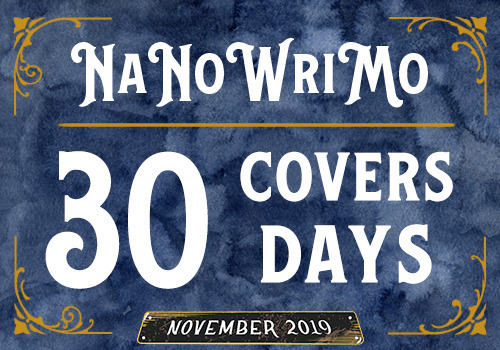
Hello, Wrimos!
Wowee, what a life! How exciting is it that NaNoWriMo is (almost) upon us once more, and with it, that annual festival of design and delight! That yearly event of visuals and very exciting stuff! That once-in-every-12-monthly convention of pictures and… parables?
Yes, indeed, I’m talking about 30 Covers 30 Days!
For those of you not in the know (and if you are not in the know, you are valid and welcome), 30 Covers 30 Days is an event in which thirty enterprising novelists (23 NaNoWriMo participants, and 7 Young Writers Program participants) are selected to receive spiffy, bespoke covers from a group of talented (and very generous with their time) graphic designers.
It’s wild fun, it ropes graphic designers into our month of frenzied creativity, and it’s a fantastic showcase for writers and designers alike!
Our good friend Debbie Millman helps us coordinate it every year, so let’s give her a big round of electronic applause.
So what do you do if you want one of these fancy, brand-new, and completely original covers?
Just fill out this nomination form. You can nominate somebody else’s novel (ideally with their permission), or your own.
A few things to be aware of:
Your real/legal name is not required. If have a preferred name, pen name, or any other kind of name you would like to use, that’s OK by us!
The submission form will remain open until November 15th. If you don’t quite know what your novel is about yet, don’t worry! Take a week or two to figure it out, and then submit! There’s no priority based on submission date.
If your novel is selected, we’ll get in touch with you for final confirmation!
Visit the NaNo Artisans Forum! If you want to try your hand at making a cover, or if you just can’t imagine enduring the suspense of 30C30D, it’s a great place to connect with other people! Be nice to each other out there!
After you nominate a novel, there’s nothing much to do but wait.
That’s fine, though, right? As Milton reminds us, “they also serve who only stand and wait.”
(But, seeing that NaNoWriMo is just around the corner, don’t listen to Milton. He was probably lazy and almost certainly never wrote a novel in a month).
So what are you waiting for, Wrimos?
NOMINATE YOUR NOVEL FOR 30 COVERS, 30 DAYS!
Good luck!
-Freddy
October 14, 2019
Do’s of Writing People of Color: Read What We Write
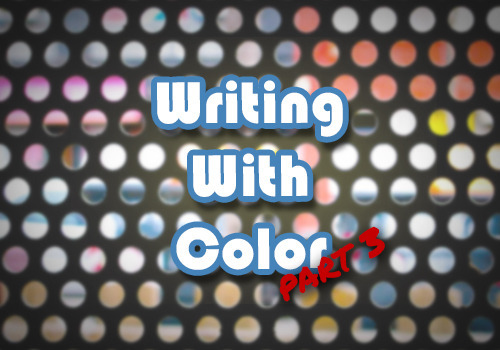
Diversity makes stories better, plain and simple. This year, we’ve partnered with the good folks at
Writing With Color
to get some advice on how to write stories populated with people of all racial and ethnic backgrounds. In the second part of her “Do’s of Writing People of Color” sub-series, founder
Colette Aburime
discusses how reading diversity will help us write diversity:
Writers write. They should also read. And if you plan on writing Characters of Color, you should read works by People of Color. More specifically, stuff from authors in that ethnic group. Consider this an important part of your research.
How do People of Color tell their tales, express culture, and represent themselves in story? You may find that—ope! We humans are quite alike in many regards.
It’s those key differences you should learn to add a touch of authenticity.
Whether it’s:
Haircare needs & stylesHow we describe ourselvesMicroaggressions: the ones we face & how we copeHow we incorporate, celebrate and balance cultureFitting in at work and schoolWhen the mods and I give advice on WritingwithColor, we speak mainly from our experiences. Don’t stop at just one book or blog. There are many more voices to hear. Seek plenty of stories by those you hope to represent.
Primary Resources:
Fiction - particularly in your story’s genreNon-fictionBlogs and vlogsArticlesPOC Profiles on WritingwithColor blog (reader submission-based experiences)Autobiographies, diaries and memoirs - particularly in your story’s time periodSocial media / message boards (Twitter, Tumblr, and Reddit can be an open diary!)Comment sections, reviews, and discussions from any number of these.Remember your goal is to learn and to listen.
Tips:
Practice proper etiquette. When entering public or semi-private spaces, provide support without offering unasked-for sympathies or questions. “Thank you for sharing” is a good general way to show support. Or sometimes lurking is best. Regardless, make sure all commentary is welcome and appropriate.For example: A Black girl venting about getting her hair pet by a coworker isn’t the time to ask “Well, why is it so wrong to do that?” Google is a good, dear friend!
Keep an open mind. Some of these sources may share raw, intimate information. Truths that make you uncomfortable, told in ways that don’t sugarcoat or act nice about it. Time to forget yourself! A person’s personal experiences are seldom written to make others comfortable. Again, you’re here to listen and learn. And you will learn if you listen!Support Authors of Color. When it comes to stories, support the author with a review. And if you liked it, recommend the book to others. You could also buy a copy or ask your library to carry it.
It’s not all about oppression.
Something you’ll discover from reading our stories, particularly fiction; we want adventures! To fall in love, crack the cold case, and soar from the backs of dragons. Most of our lives are not 24/7 about The Struggle.
In any case, stories that let us play is part of escapism. Allow us these moments. When we’re ready for really tough stuff, we’ll seek the stories that deal specifically with those topics.
And don’t forget all the positive to neutral things. Food, holidays, traditions, music, get-togethers…
Overwhelmed?
Don’t get lost in the details. Not everything you learn will prove relevant to the story, but it could provide some background. In the same way giving your MC the favorite color yellow may never appear on the pages, it gives insight on who they are.
Organize to Success!
Chart your findings in a neat and easy to reference manner.
I’ve created this Character of Color Research Table (Google Doc) to give you a start. Make a copy and fill the chart with whatever information you see fit.
Now, pick up a great book by an Author of Color and get in some research!

Colette Aburime is the founder of WritingWithColor, a writing advice blog focused on diversity. She studied creative and professional writing in college, and writes (or rather, dreams of writing) in her free time. Colette is a big fan of romance and fantasy and lives out her fairytale in a humble cottage in Minnesota’s Twin Cities. She spends happily ever after with her prince, plants, and a feisty cat. Check out WritingWithColor on
Tumblr
and
Twitter
.
October 11, 2019
Road Trip to NaNo: The Power of Myth

November is coming. To get ready, we’re taking a road trip to visit Wrimos from around the world, and hear about how their regions can inspire your writing. Today, Wales Municipal Liaison Katie Price talks about Celtic mythology, and how myths can help you give texture to stories:
Bordered by England to the east and by sea in all other directions, this small, yet breathtaking country boasts home to a population of 3 million. Famous for its rugged coastlines, rolling hills, valleys, and majestic mountains, artists of all forms are never short of inspiration for their crafts when they gaze upon the vibrant country of Wales.
Apart from its beautiful landscapes, Wales is also famous for its many myths and legends. Each handed down over the centuries from their Celtic ancestors.
From pilgrims and knights in King Arthur’s court to giants, lake maidens, fairy folk, and dragons, Wales is steeped in fantastical lore.
Shared throughout the ages as proverbs and songs, in addition to thrilling spoken and written stories, these myths have shaped the way Wales has grown and many towns gained their names through onomastic lore (lore which explains place names). Along with this, Wales is one of only two countries in the world to have the mythical dragon on its national flag.
In a country surrounded by mythology, and awe-inspiring scenery, it is no wonder that creative writers and novelists (especially those who participate in NaNoWriMo) tend to choose ‘Fantasy’ as their genre of choice.
I am one such novelist.
Growing up around all this mythology, it didn’t take long for my malleable young mind to become fascinated by fantasy and conjure up magical stories of my own, drawing on those familiar myths and legends as inspiration for my own writing. In fact, the novel I began writing five years ago and will be continuing for NaNoWriMo 2019 is a retelling of the Welsh changeling child myth.
Welsh mythology and lore certainly played a significant role in my journey as a writer and, no doubt, in the journeys of many other writers throughout the ages.
Even if your writing style or genre of choice is the furthest thing from ‘fantasy’, myths can still play an important role in the development of your characters and the worlds they reside in.
Myths exist in every culture and country across the world. No matter where you are, there is always some story that a local might relate to you as warning or clarification as to certain events, locations, or names.
They are traditional, usually ancient, stories involving supernatural beings, ancestors, or heroes used to explain aspects of the natural world, show the psychology, customs, or ideals of a society, and sometimes, to explain the unexplainable.
If you are truly committed to your craft and to delving deeper into the worlds and minds of your characters, try using myths to do this. Let them add historical meaning and cultural background to your characters and the locations in your novel.
Whether you choose to write fantasy, historical fiction, romance, or any other genre of book, the fact remains that myths shape communities and countries as well as individual’s beliefs, attitudes, fears, and superstitions.
Explore what myths may have shaped the past and attitudes of your characters. Delving into their minds in this way will help you get a better insight into why they act or feel a particular way.
If you’re up for a challenge, try writing a myth to explain:
Why the sun risesWhy it snowsWhy leaves change colorWhy the moon changes shapeWhy people are different colors; orTo explain the changing tidesIf all else fails, a recollection and recounting of a myth from their past is a good way to keep the momentum flowing during NaNo and add a neat little chunk of words to your word count.

Katie Price is a first-year CO-ML for the Wales region and active participant of NaNoWriMo since 2012. After a 5 year career in Business Admin and Finance, she left the business world behind to raise a family and is now a devoted mother to her 2-year-old daughter and 3-year-old autistic son. When she can find the time she enjoys writing Fantasy, Sci-Fi, and YA Romance.
Top image licensed under Creative Commons from felizfeliz on Flickr.
How NaNoWriMo Can Actually Help Your Mental Health

Writing a novel in a month can be hard—even harder when dealing with mental health. In this post, NaNoWriMo Participant Hannah Blackwell talks about how NaNoWriMo is not only possible with mental health problems, but potentially beneficial:
It’s almost an understatement to say that life is overwhelming. This holds especially true during NaNo season. Juggling life, employment, family, friends, and a fifty thousand word novel requires at least two hands, and that becomes especially hard when a writer deals with mental illness too.
Last year, my first ever year with NaNo, I had just been diagnosed with Obsessive Compulsive Disorder and Post-Traumatic Stress Disorder. On top of that, I’d just started a new job that wasn’t going particularly well. I almost didn’t do it - I wouldn’t have if I hadn’t broken my foot and needed something to do while recovering. I’d nearly given up on writing altogether, and accepted that I might never finish a novel. I was just going to put all of my passion away. But I knew that writing was something that I loved, and I hoped that if nothing else, writing would give me a positive headspace to recover in.
A few days into the writing process, I decided to explore the NaNo forums, a wonderful place full of interesting people. I’d perused a few teacher threads, a few video game ones, a few for my genre. Then I stumbled on a thread for other people my age with mental health issues. Curious, I checked it out.
At first, I thought it would be a place to come and rant when I was upset, or complain when all of my energy was spent, or just release steam after work. I never really expected any of these people to be more than users on a forum. But every day I would find encouraging messages, leave support, and gain valuable advice that helped me not only reach my word count, but complete my entire novel, which I’m still currently editing. We even made a separate group chat to talk in, and to this day I still talk with the people that lifted me up doing NaNo.
It is a relief to know that there are people who feel the same way that you do when you’re alone. It’s even better to know that there are kind and supportive people out there who not only understand, but encourage you to do your best. No one should have to feel alone, which is why reaching out and communicating is such a valuable thing that sometimes we take for granted. This year, I have already taken a head start in making a thread for those who might need some encouragement during the stresses of NaNo.
Encouragement is a necessity for EVERYONE, not just people with mental health issues. Writing a book is HARD. It’s intimidating as hell. There are so many times when I wanted to give up on my writing, and all it took was someone to say, hey, maybe it doesn’t mean anything, but I believe in you. Drink some water, and have a really wonderful day. Kind words can absolutely go an extra mile.
If you’d like to be a part of the Support Squad, I encourage you to look on the boards for a place to talk to others. It can be a wonderful thing to pass on some encouragement to others. And if you need some support, there are plenty of us here for you.

Hannah Blackwell has been participating in NaNoWriMo since 2018. She likes to write YA Fantasy and SciFi books when not working at her job as a music teacher. Currently, she is working on turning her first NaNo project into a fully published novel. She lives in central Illinois with her cat, Gigi, and her soon to be husband. If you’d like to connect with her, she is on Twitter, Pinterest and her NaNoWriMo username is FrenchToastOk
October 10, 2019
Properly Coded: Creating Characters of Color (Part 1)
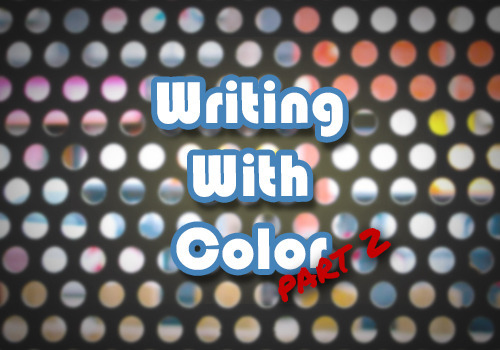
Diversity makes stories better, plain and simple. This year, we’ve partnered with the good folks at Writing With Color to get some advice on how to write stories populated with people of all racial and ethnic backgrounds. In this post, Alexa White gives advice on finding the right voice for characters of color:
The #1 thing I tell people on Writing With Color when they provide a character for review is “this sounds like a white person.”
I don’t say it as a condemnation, but to provide a baseline for what people are working with. They are working from an environment where white narratives, white people, and white-majority countries are the only places deemed “worthy” of their history, culture, and physical location being explored.
As a result, most characters come across as white. Their thought patterns, mental framework, and values don’t feel like they reflect the realities of growing up as someone othered. There aren’t enough details, the priorities feel wrong, and the cultural touchstones are just not there.
Thankfully, the internet is very vast, and has provided people multiple ways to respectfully research everything you could need. Here are three basic steps (in no order) you can take to begin creating characters of color:
1: Listen in on social mediaKey word: listen. The goal of this step is to familiarize yourself with communities that are speaking as if white people aren’t around. You can do this on any social media platform.
How to find these communities can be tricky. A great place to start is going through Writing With Color’s tags meant to gain community commentary (NDN only), following activist accounts (black lives matter), and just generally searching “x activist” (googling Asian activism got me a Wikipedia article on Asian-American activism, with the name of multiple movements, activist organizations, and notable activists. Note: it’s very East Asian heavy, but you can tailor searches for specific groups by name).
The more you listen, the more you’ll start to see what conversations are a priority for these groups. And don’t stop at the big names! Smaller accounts are important to follow, to get the big picture.
2: Read #OwnVoicesThe wonders of the internet have provided us with a whole hashtag that centralizes diverse authors as the authorities on their own stories. It’s a built-in reading list for so many groups, and it’s basically guaranteed that you’ll find a large collection of stories that match your demographic.
Reading stories by people of color will help combat the overflow of white-centered stories in mass media, which will in turn provide you with a different framework to work from. Details you hadn’t even thought of (like satin pillowcases for type 4 curly hair) will start to emerge, and you’ll get a window into how someone chose to present themselves (which is a big deal when closed religions start to come into effect, such as many Native religions).
Plus, you get to support authors of color along the way, and have a bunch of new stories to recommend!
3: Google every basic you can think of (and make sure the sources are reputable)The literal only reason writing Europeans and white Americans is easier is because you’ve had their history spoon fed to you since kindergarten. You’re going to need to start from kindergarten level questions for your characters of color.
As alluded to multiple times in this post, the internet is full of content by people of color. You can find Japanese recipe blogs, Black makeup and hair YouTubers, Native fashion stores—the list is endless. So long as the source is someone from the group, chances are you’ll be getting something accurate.
By googling your questions, you can start to fill up the education cup without demanding any extra labor from people of color. We have already provided the labor for you. All you need to do is find it, and withhold the impulse to insert yourself into the narrative.
This isn’t about you. Learn to let it be about us, before you start writing.
Good luck on your research quest!
~ Alexa White

Alexa White, also known as Mod Lesya on Writing with Color, is a Mohawk two spirit person from Southern Ontario, who joined Writing with Color to help educate others. A lifelong lover of storytelling, she dedicates her focus to making characters feel like they come from whatever setting they’re supposed to exist in. If she is not found writing, she is playing with her cat, cooking, or drawing.
October 9, 2019
3 Reasons Every Writer Should Read More

Every year, we’re lucky to have great sponsors for our nonprofit events. Today, Scribd, a 2019 NaNoWriMo sponsor, shares how you can boost your writing skills through reading. Try out Scribd’s reading subscription service for free!
If you ask any seasoned writer for advice, it’s practically a guarantee that clichéd exhortations to “read more” will be among their suggestions.
It’s difficult to blame writers seeking guidance to tune out this advice when they hear it, conditioned as they are to being told they’re not reading enough. But this advice should be taken seriously. Even those who are already avid readers and can’t possibly pack more reading time into their days will benefit from adjusting their relationship with reading.
Pro writers cite diverse reasons for becoming compulsive, eclectic readers. Here are a few of them:
Writers don’t like to admit it, but it’s the truth: Grammar is hard. The rules of grammar are often counterintuitive, arbitrary, nebulously defined, and subject to change. Style guides provide contrasting explanations of certain rules, and many of them require annual updates. If it feels like it’s impossible to truly master syntax, punctuation, and word choice, that’s because it nearly is.
We can take solace in the fact that “proper English” is a human construct and not fully “getting it” is largely inconsequential. You, however, are a writer, so correct grammar is important for your purposes. The good news is that “correct grammar” isn’t as rigid as you may have been led to believe. Writers have been using grammar creatively for a long time now, from the stages of Elizabethan England to the cafés of postmodern New York, and you have unlimited material to draw stylistic and grammatical cues from. Take advantage of it! The more authors you read, the better able you’ll be to nail down a style that best reflects your vision. And, of course, if the fundamentals are still beyond your grasp, there’s no better way to master them by immersing yourself in them.
2. Getting inspiredIn the second century CE, the Greek author Plutarch wrote one of his most famous works: Parallel Lives, an account of the lives of 48 Greek and Roman public figures. A 1579 English translation of Parallel Lives—one book!—would form the basis for four plays by William Shakespeare.
This isn’t meant to suggest that you should indiscriminately plunder ideas like Shakespeare did, but to illustrate the inspirational power of reading. If one book (albeit a pretty big one) gave the English language’s most beloved writer four plays, think of how many ideas you could get out of reading all the time. Inspiration can come from unexpected sources; why not seek it out?
Here’s another (true) cliché: Literature is defined by its ability to expand our capacity for empathy. Understanding is at the core of empathy, and learning about experiences different from our own is how we develop understanding. You might read books by and about all different sorts of people, and that’s great! But people have written about everything under the sun, and no matter how much you know, there will always be more to learn, more worlds for you to explore. Everyone gets caught in “bubbles” of preferences and interests and experiences, but reaching outside those bubbles by reading a diverse selection of books can make us better people, which makes us better writers.
From the Russian avant-garde to 18th-century recipes to cricket technique to squirrel behavior to the lives of workers on the Transcontinental Railroad, there have been books written about everything, including many, many things you aren’t even aware of—yet. With reading subscription service Scribd, you get access to millions of books, audiobooks, documents, and more, to help you expand your reading horizons, all for around $10 a month. You can sign up for Scribd here, and get 30 days free to check it out.
Read more, get acquainted with the world around you, and write all about it!

Karyne is the Senior Original Content Manager at Scribd. Prior to that she was an assigning editor at NerdWallet, West Coast Tech Editor at Business Insider, and Assistant Managing Editor at CNET. Her varied interests include singing, playing video games, and reading good hard-boiled detective novels.
Top photo by Annie Spratt on Unsplash.
October 8, 2019
The Do’s of Writing People of Color: Start on Easy Mode

Diversity makes stories better, plain and simple. This year, we’ve partnered with the good folks at
Writing With Color
to get some advice on how to write stories populated with people of all racial and ethnic backgrounds. In this post, founder
Colette Aburime
gives advice on how to begin incorporating diversity into your writing:
When you write with racial and ethnic diversity, you hear a lot about what to avoid. Now, it’s not without good reason. The road to good representation is paved with harmful stereotypes and worn-out depictions of People of Color. Advice-givers, like me and the rest of the folks at WritingwithColor, put up caution signs and leave the rest of the journey up to you.
Still, there are some do’s that make for both good writing and good representation.
Writers tend to think big. Our craft demands that we keep our brains fired up with ideas.
I’m asking you to think small.
You wouldn’t set out to climb Mount Everest your first day as a climber. No way - you’d train first! It’d take loads of exercise, you might scale some indoor climbing walls, and perhaps stock up on wisdom to apply to your own form.
When approaching topics you have little experience with, no need to go the biggest you can go from the start. Train before tackling the full-length novel or dealing heavily in tough topics like racism. Start with a hill, not the mountain.
Benefits of starting small:Smoother writing process. The writing process can be a bit stop-and-go if you’re, say, constantly checking that your Black character descriptions are on the right track. You’ll feel more focused if you’ve described Black characters countless times before. Get the stumbling out on the training grounds.More confidence as a writer. The stakes of writing a group outside of your own can feel like mountains looming overhead. The more practice you have, even from writing snippets and scenes, the more confident you’ll become.Better representation. With all that practice prose in, combined with research and feedback, your diverse writing will only get better. You’ll learn what works, doesn’t work, and tackle stereotypes and blunders early on.
Ways to start small:Character profiles Character descriptions (physical and personality)Dialogue Third person POVFirst person POVWrite a secondary Character of ColorWrite a Protagonist of ColorScene with CoC during an ordinary moment Scene of CoC during an emotional moment Scene of CoC facing a micro-aggressionScene of CoC facing blatant racism or discrimination Scene that casually shows culture (e.g. dinner, clothing, family interaction)Scene that prominently shows culture (e.g. holiday, cultural event)Fan Fiction (Good source of feedback if published!)Flash fictionShort story
This list progresses from easier stuff to more complex means of practice. Try a variety of methods and practice as much as it takes to feel comfortable on a certain task. Exercise those diverse-writing muscles!
I’ve practiced a lot. Now what?Research what you’re writing. If you didn’t do it before or during writing, now’s the time to research. Check out those writing guides on describing skin tone and physical features, dialect and speech, handling stereotypes, and so on. Writingwithcolor is a good starting place! Check out the WWC FAQ and explore from there. Get feedback. Preferably from the groups you’re writing on. Again, Writingwithcolor is a resource for feedback but so are beta-readers, writing groups online and in-person, etc. Improve your practice pieces. Don’t lament too much on perfecting it but do apply research and feedback to polish them up. Remember the relevant advice for future reference.
It’s great that you’re writing with diversity! Now that you’ve got the small stuff out of the way, pull out those big plans you kept tucked in your back pocket. You’ll stumble a lot less with all the practice you’ve already clocked in.

Colette Aburime is the founder of WritingWithColor, a writing advice blog focused on diversity. She studied creative and professional writing in college, and writes (or rather, dreams of writing) in her free time. Colette is a big fan of romance and fantasy and lives out her fairytale in a humble cottage in Minnesota’s Twin Cities. She spends happily ever after with her prince, plants, and a feisty cat. Check out WritingWithColor on
Tumblr
and
Twitter
.
October 7, 2019
Having the support of friends, family, or other important people...

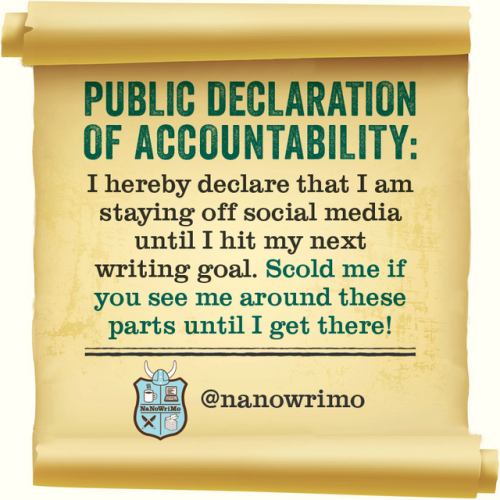
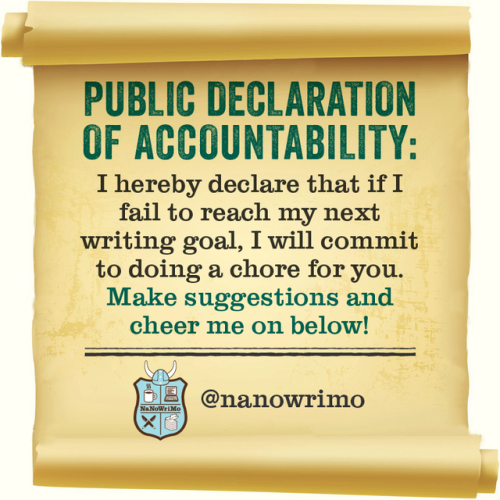

Having the support of friends, family, or other important people in your life can help you accomplish your creative goals.
We’ve come up with these graphics that you can share to help the writer-adjacent people in your lives best understand how they can support you during November—whether that’s by keeping you off social media when you should be writing, coming up with chores for you to do if you don’t reach your goals, or participating in NaNoWriMo with you! Tag or share with someone you’d like to write with next month.
IMAGES:
1. Writing Buddy definition
Noun: A person who writes with another person, offering encouragement and support, including but not limited to:
a. Accountability
b. Cheerleading
c. Real Talk: i.e. “…You know you chose to do this, right?”
Bring your own writing buddy #BYOWB
2: Public Declaration of Accountability
I hereby declare that I am staying off social media until I hit my next writing goal. Scold me if you see me around these parts until I get there!
3: Public Declaration of Accountability
I hereby declare that if I fail to reach my next writing goal, I will commit to doing a chore for you. Make suggestions and cheer me on below!
4: Public Declaration of Accountability
I hereby declare that upon reaching my next writing goal, I will join one of you for a celebratory treat. Make a date with me or cheer me on below!
October 3, 2019
Road Trip to NaNo: Diversity Among the Small and Mighty

November is coming. To get ready, we’re taking a road trip to visit Wrimos from around the world, and hear about how their regions can inspire your writing. Today, Tel Aviv Municipal Liaison Naomi Greenberg talks about how diversity can fuel both writing and friendship:
People call Tel Aviv a bubble, and it’s true. A city of skyscrapers on the Mediterranean Sea, Tel Aviv seems to exist as a world of itself. when you’re in Tel Aviv, the troubles on the outside seem to matter less.
When I started as an ML in Tel Aviv nearly three years ago, I didn’t know what to expect. I had lived in the area for several years, but there hadn’t been an ML for a while. At our first write-in I told myself that if even one person came, it would be a success. When twelve people showed up and came consistently all month, I was ecstatic. Our small yet vibrant group has included WriMo-ers from the USA, UK, Russia, France, Switzerland, South Africa, Ethiopia and of course Israel over the past two years.
I shouldn’t have been surprised. Our region is a reflection of our city in the best possible way. We are small and mighty. We are bilingual- almost everything is done both in Hebrew and in English, so that everyone can understand. We have people who have lived in Tel Aviv their whole lives, newcomers, and those just passing through, for a few weeks or few months. I think our diversity and fluidity gives us power, and we reflect the general population of the city. Walking down the street you will see women in burkas, teens on electric scooters, tourist groups of nuns, refugees from Somalia, new immigrants from France, business people on motorcycles, Hasidic Jewish men with long beards, and a never ending amount of young parents pushing babies in strollers.
Tel Aviv is vibrant and never stops moving. Sometimes I wonder if there is a mode of transportation that hasn’t been tried in Tel Aviv. There is an endless passing of scooters, bicycles, skateboards, hoverboards, cars, trains, busses and motorcycles. There is never enough parking and never an electric scooter available to rent when you need when. Everyone smokes, drinks coffee, and sits at the beach on their phone. It’s over 30 Celsius six months out of the year, and when it rains for five minutes it is treated like a natural disaster. The constant movement makes it so it’s never boring here.
Being the ML in Tel Aviv has made me some of my best friends and introduced me to more coffee shops than I care to admit. It has taught me how to connect with the people around me and how despite what it may seem, we are more alike than we are different. The sense of community has led to a year round WhatsApp group, joint photography projects, birthday parties, and lots of writing every month of the year. Just like the city of Tel Aviv, our region is never quiet.
As a person who draws inspiration from the people and places around me, MLing in Tel Aviv has taught me that everyone has a story to tell. It’s also taught me to see the humor in everyday things, like a heated political argument with your taxi driver or how the entire office closes early because of the FIFA World Cup. Adding everyday details into my writing that I pull from my everyday experiences helps me create more developed characters in a more believable world.
In the spirit of cities and people and noise, try to take a few minutes to sit outside and people watch. Try to incorporate some of the people and things that you see into your writing. I recommend coming armed with a notebook, a cappuccino, and a place that’s new to you, for the best results.
NaNoWriMo in Tel Aviv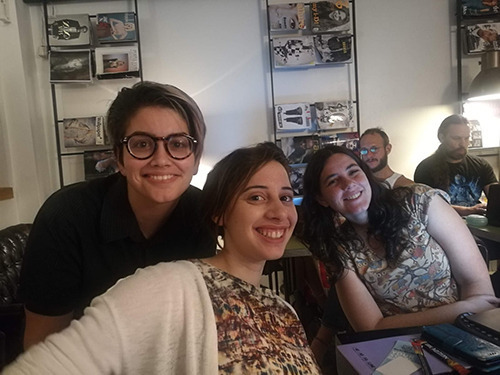
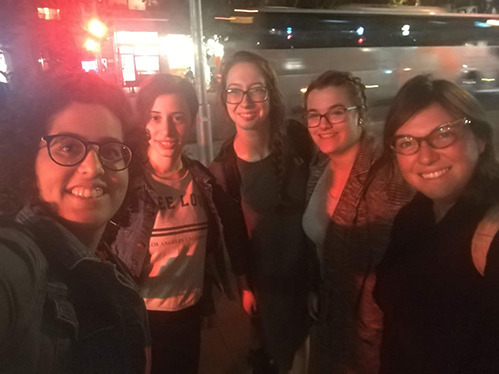
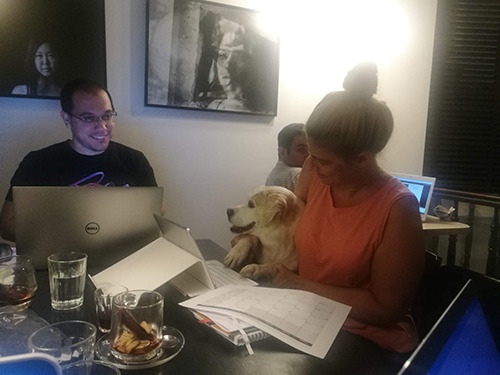

When she isn’t ML-ing in Tel Aviv, you can find Naomi at her office, where she daylights as an intellectual property lawyer. Naomi is 24 years old and spends her free time spending too much money on books and coffee, and forcing her friends to see musicals with her. Naomi has participated in Nanowrimo since high school, and she has written everything from sci-fi to epic fantasy, from chick lit to historical fiction.
Top image licensed under Creative Commons from xiquinhosilva on Flickr.
Chris Baty's Blog
- Chris Baty's profile
- 63 followers



